Henslin James M. Sociology: A Down to Earth Approach
Подождите немного. Документ загружается.

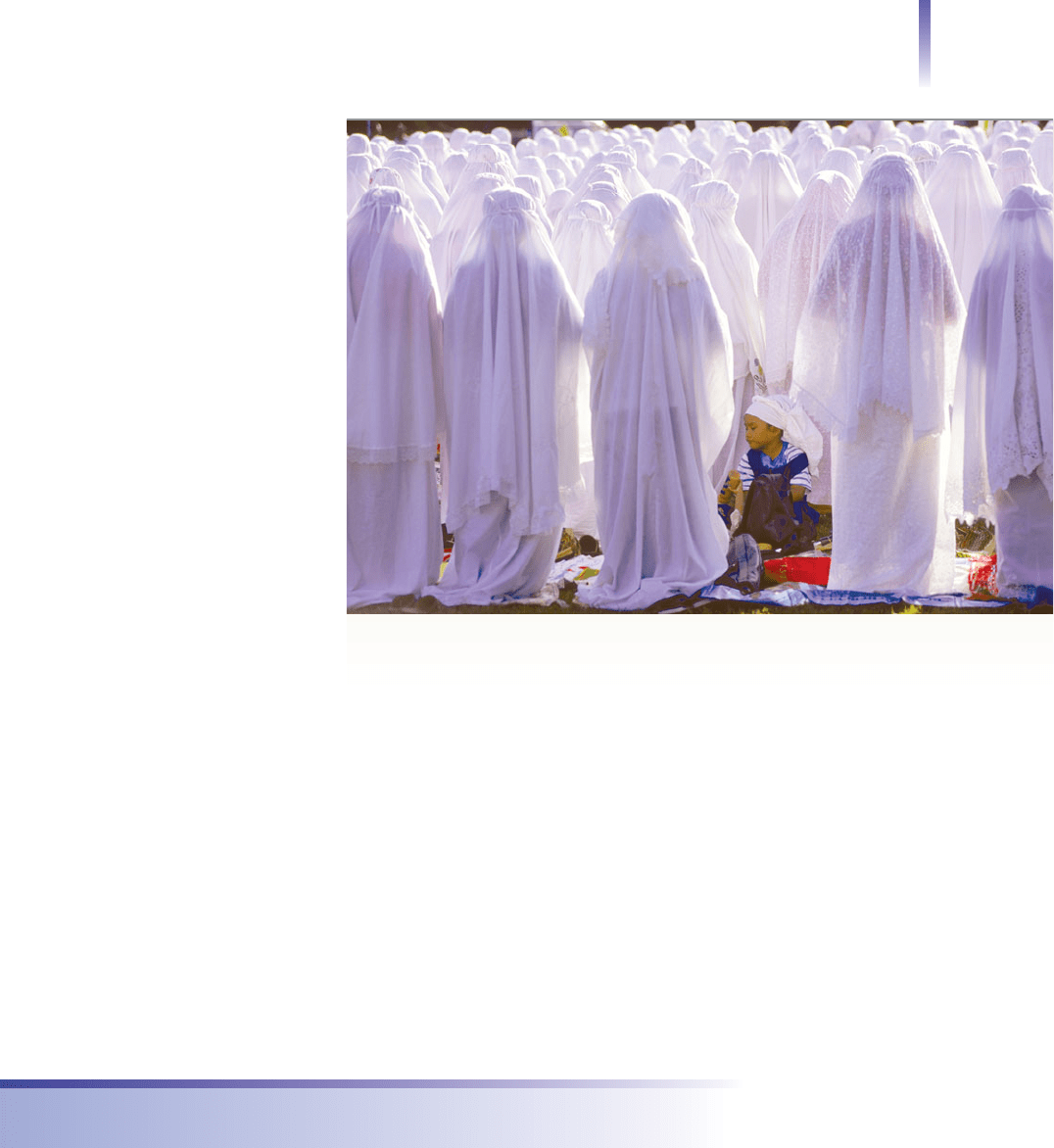
together—and at the same time sepa-
rate them from those who do not
share their unique symbolic world.
Mormons, for example, feel a “kin-
dred spirit” (as it is often known) with
other Mormons. Baptists, Jews, Jeho-
vah’s Witnesses, and Muslims feel sim-
ilar bonds with members of their
respective faiths.
As a symbol of their unity, members
of some religious groups address one an-
other as “brother” or “sister.” “Sister
Luby, we are going to meet at Brother
and Sister Maher’s on Wednesday” is a
common way of expressing a message.
The terms brother and sister are in-
tended to symbolize a relationship so
close that the individuals consider
themselves members of the same family.
Community is powerful. Not only
does it provide the basis for mutual
identity but also it establishes norms
that govern the behavior of its mem-
bers. Members either conform or they
lose their membership. In Christian
churches, for example, an individual
whose adultery becomes known, and who refuses to admit wrongdoing and ask forgive-
ness, may be banned from the church. He or she may be formally excommunicated, as
in the Catholic tradition, or more informally “stricken from the rolls,” as is the usual
Protestant practice.
Removal from the community is a serious matter for people whose identity is bound
up in that community. Sociologists John Hostetler (1980), William Kephart, and
William Zellner (Kephart and Zellner 2001) describe the Amish practice of shunning—
ignoring an offender in all situations. Persons who are shunned are treated as though
they do not exist (for if they do not repent by expressing sorrow for their act, they have
ceased to exist as members of the community). The shunning is so thorough that even
family members, who themselves remain in good standing in the congregation, are not
allowed to talk to the person being shunned. This obviously makes for some interesting
times at the dinner table.
The Conflict Perspective
In general, conflict theorists are highly critical of religion. They stress that religion supports
the status quo and helps to maintain social inequalities. Let’s look at some of their analyses.
Opium of the People
Karl Marx, an avowed atheist who believed that the existence of God was impossible, set
the tone for conflict theorists with his most famous statement on this subject: “Religion
is the sigh of the oppressed creature, the sentiment of a heartless world. . . . It is the
opium of the people” (Marx 1844/1964). By this statement, Marx meant that oppressed
workers find escape in religion. For them, religion is like a drug that helps them to forget
their misery. By diverting their thoughts toward future happiness in an afterlife, religion
takes their eyes off their suffering in this world, reducing the possibility that they will
rebel against their oppressors.
The Conflict Perspective 531
One of the functions of religion is to create community—a sense of being connected with
one another and, in this case, also a sense of being connected with God.To help accomplish
this, religions often use rituals. Shown here are Javanese Muslim women in Surinam as they
celebrate Id al Fatr at the end of Rammadan.
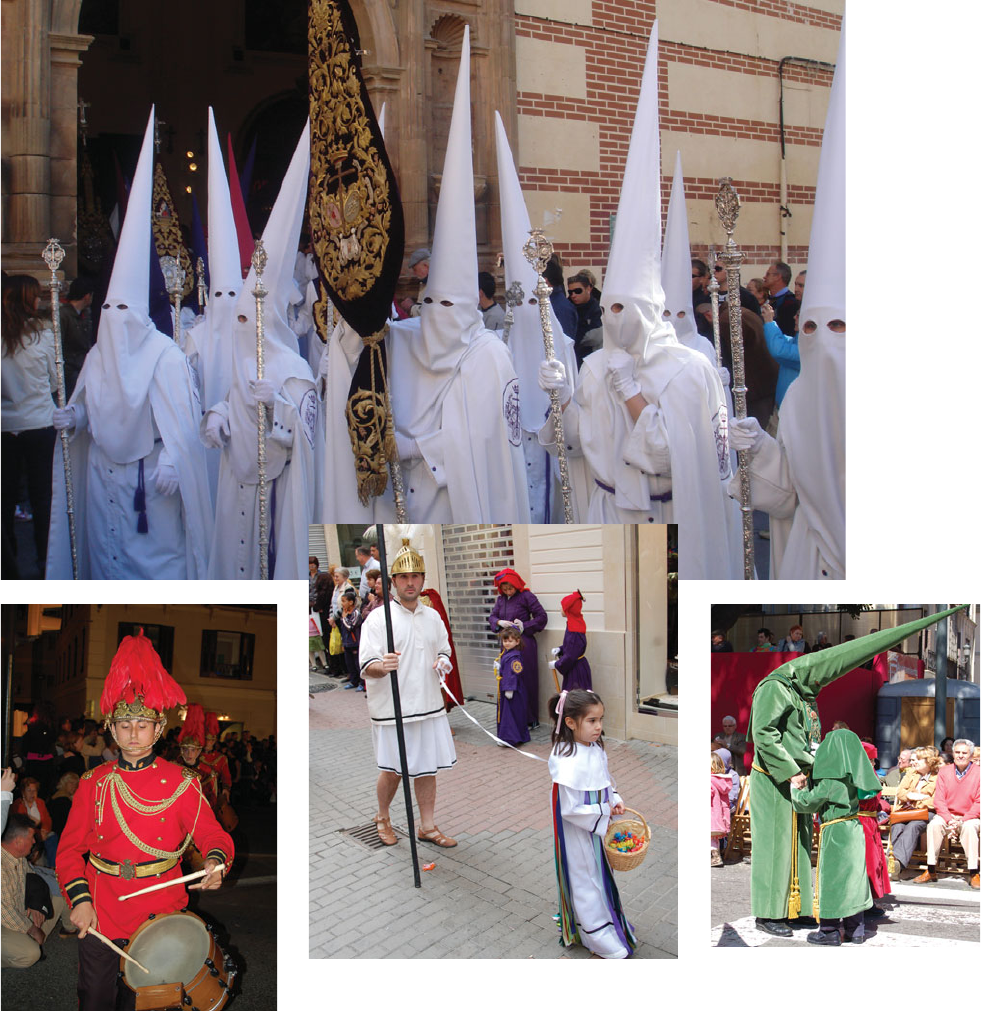
Bands, sometimes several of them,
are part of the processions.
A group of
participants exiting
the Church of the
Incarnation for
Malaga’s Easter
procession.
The procession in the village was more informal.
This Roman soldier has an interesting way of
participating—and keeping tabs—on his little
daughter.The girl is distributing candy.
Holy Week in Spain
THROUGH THE AUTHOR’S LENS
r
eligious groups develop rituals designed to evoke memories,
create awe, inspire reverence, and stimulate social solidarity.
One of the primary means by which groups, religious and sec-
ular, accomplish these goals is through the display of symbols.
I took these photos during Holy Week in Spain—in Malaga
and Almuñecar. Throughout Spain, elaborate processions
feature tronos that depict the biblical account of
Jesus’ suffering, death, and resurrection. During the
processions in Malaga, the participants walk slowly
for about two minutes; then because of the weight
of the tronos, they rest for about two minutes.This
process repeats for about six hours each day.
Parents gave a lot of attention to their
children both during the preparations
and during the processions.This
photo was taken during one of the
repetitive two-minute breaks.
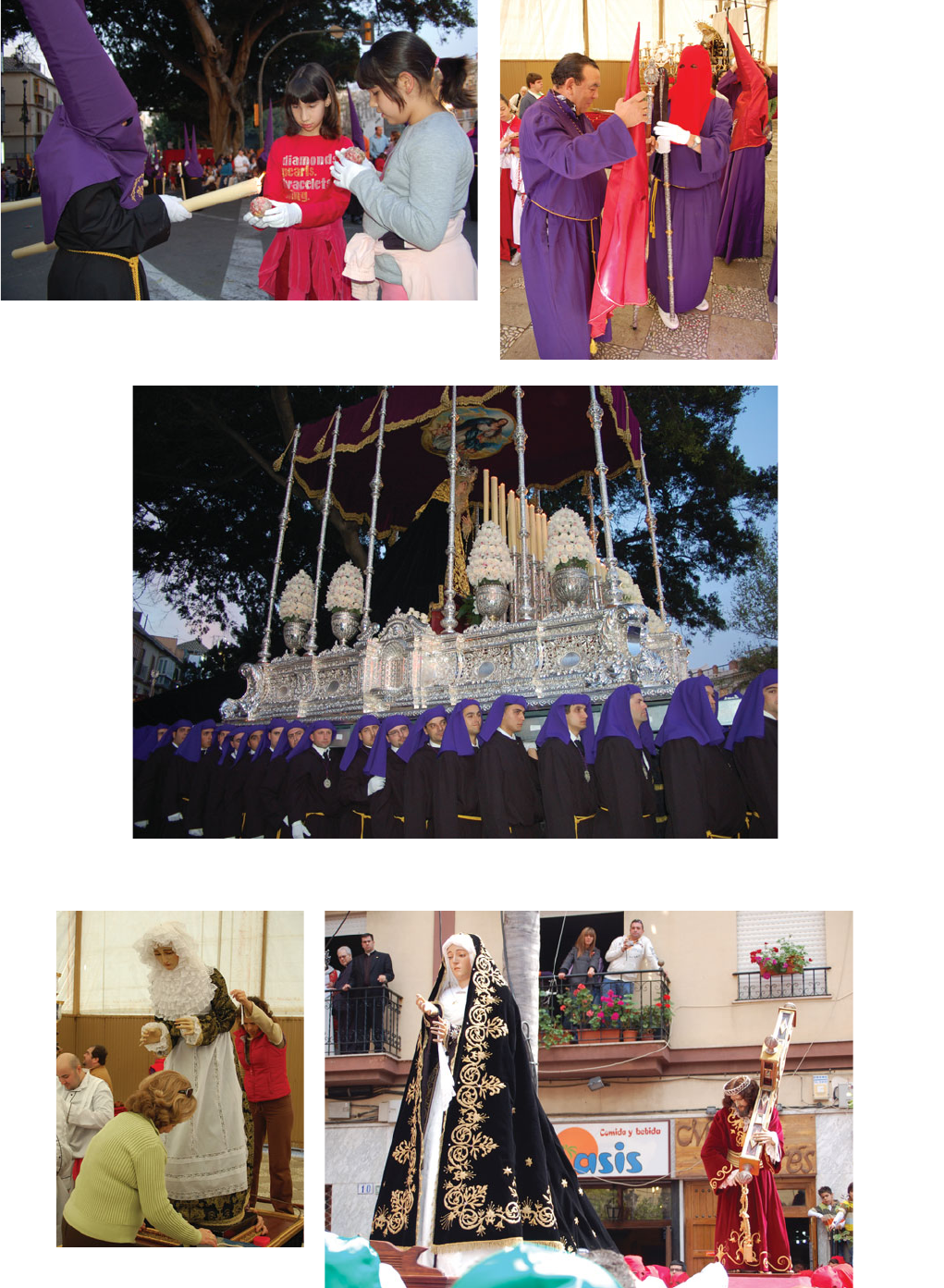
For the Good Friday procession, I was
fortunate to be able to photograph
the behind-the-scenes preparations,
which are seldom seen by visitors.
Shown here are finishing touches being
given to the Mary figure.
The town square was packed with people awaiting the procession. From one
corner of the square, the
trono of Jesus was brought in.Then from another, that
of Mary (“reuniting” them, as I was told). During this climactic scene, the priest
on the balcony on the left read a message.
During the short breaks at the night processions, children from the
audience would rush to collect dripping wax to make wax balls.This was
one way that the audience made themselves participants in the drama.
Beneath the costumes
are townspeople and
church members who
know one another well.
They enjoy themselves
prior to the procession.
This man is preparing to
put on his hood.
Some tronos were so heavy that they required many men to carry them. (Some required
over 100 men.) This photo was taken in Malaga, on Monday of Holy Week.
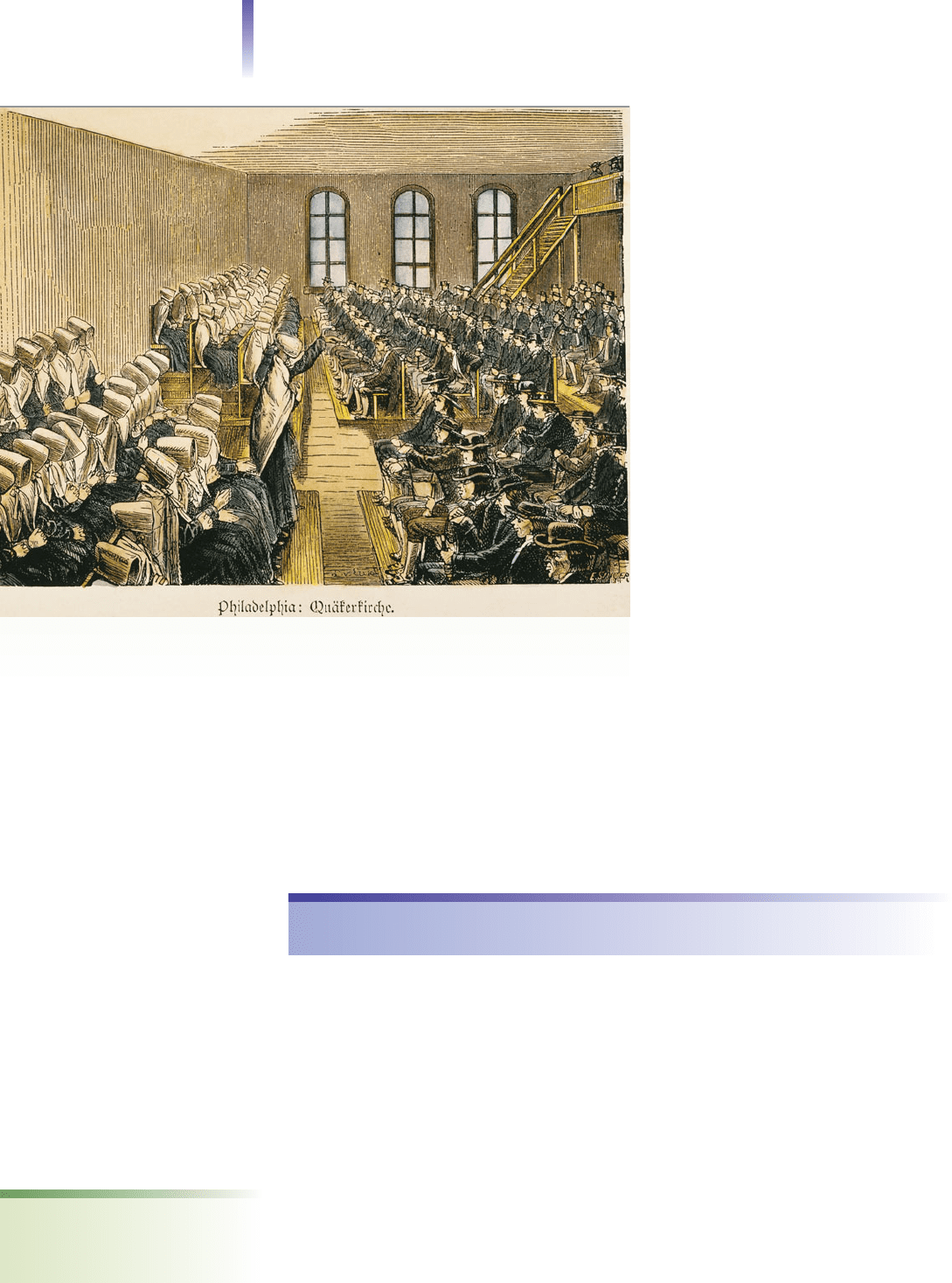
A Legitimation of
Social Inequalities
Conflict theorists say that religion le-
gitimates the social inequalities of the
larger society. By this, they mean that
religion teaches that the existing social
arrangements of a society represent
what God desires. For example, during
the Middle Ages, Christian theologians
decreed the divine right of kings. This
doctrine meant that God determined
who would become king and set him
on the throne. The king ruled in God’s
place, and it was the duty of a king’s
subjects to be loyal to him (and to pay
their taxes). To disobey the king was to
disobey God.
In what was perhaps the supreme
technique of legitimating the social
order (and one that went even a step
farther than the divine right of kings),
the religion of ancient Egypt held that
the pharaoh himself was a god. The em-
peror of Japan was similarly declared di-
vine. If this were so, who could ever
question his decisions? Today’s politi-
cians would give their right arm for
such a religious teaching.
Conflict theorists point to many
other examples of how religion legitimates the social order. In India, Hinduism sup-
ports the caste system by teaching that an individual who tries to change caste will
come back in the next life as a member of a lower caste—or even as an animal. In the
decades before the American Civil War, Southern ministers used scripture to defend
slavery, saying that it was God’s will—while Northern ministers legitimated their re-
gion’s social structure by using scripture to denounce slavery as evil (Ernst 1988; Nauta
1993; White 1995).
Religion and the Spirit of Capitalism
Max Weber disagreed strongly with the conflict perspective that religion merely reflects
and legitimates the social order and that it impedes social change by encouraging people
to focus on the afterlife. In contrast, Weber said that religion’s focus on the afterlife is a
source of profound social change.
Like Marx, Weber observed the early industrialization of European countries. Weber
wondered why some societies embraced capitalism while others held onto their tradi-
tional ways. Tradition was strong in all these countries, yet capitalism had transformed
some while others remained untouched. As he explored this puzzle, Weber concluded
that religion held the key to modernization—the transformation of traditional societies
to industrial societies.
To explain his conclusions, Weber wrote The Protestant Ethic and the Spirit of Capital-
ism (1904–1905/1958). Because Weber’s argument was presented in Chapter 7 (page
176), it is only summarized here.
1. Capitalism is not just a superficial change. Rather, capitalism represents a fundamen-
tally different way of thinking about work and money. Traditionally, people worked
534 Chapter 18 RELIGION
This engraving is of a Quaker meeting in the 1700s when women sat on one side of the
church, and men on the other. Some Jewish and Muslim groups continue this practice today.
Do you think that sex-segregated seating supports the conflict perspective that
religion reflects and legitimates social inequalities? Why or why not?
modernization the transfor-
mation of traditional societies
into industrial societies
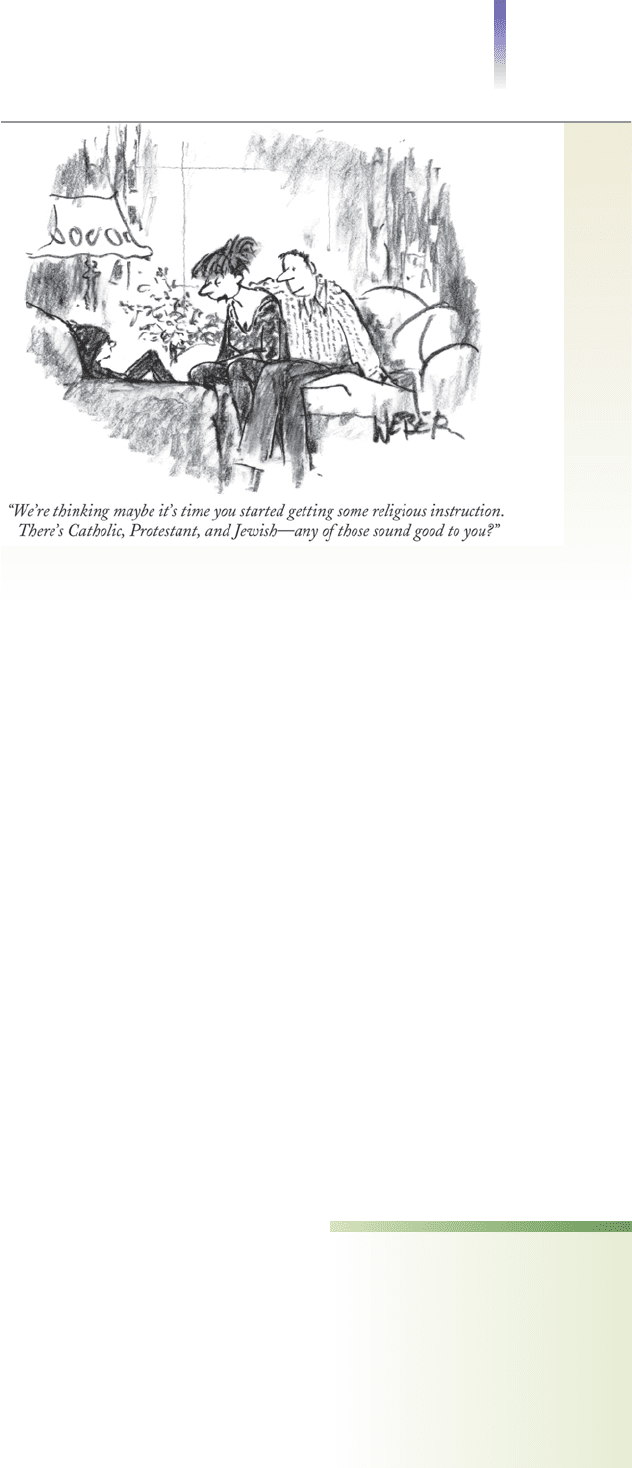
just enough to meet their basic needs, not so that
they could have a surplus to invest. To accumu-
late money (capital) as an end in itself, not
just to spend it, was a radical departure from
traditional thinking. People even came to
consider it a duty to invest money so they
could make profits. They reinvested these
profits to make even more profits. Weber
called this new approach to work and money
the spirit of capitalism.
2. Why did the spirit of capitalism develop in
Europe and not, for example, in China or
India, where the people had similar material
resources and education? According to Weber,
religion was the key. The religions of China and
India, and indeed Roman Catholicism in Eu-
rope, encouraged a traditional approach to
life, not thrift and investment. Capitalism ap-
peared when Protestantism came on the scene.
3. What was different about Protestantism, es-
pecially Calvinism? John Calvin taught that
God had predestined some people to go to
heaven, and others to hell. Neither church membership nor feelings about your re-
lationship with God could assure you that you were saved. You wouldn’t know your
fate until after you died.
4. This doctrine created intense anxiety: “Am I predestined to hell or to heaven?” Calvin’s
followers wondered. As they wrestled with this question, they concluded that church
members have a duty to prove that they are one of God’s elect and to live as though
they are predestined to heaven—for good works are a demonstration of salvation.
5. This conclusion motivated Calvinists to lead moral lives and to work hard, to use their
time productively, and to be frugal—for idleness and needless spending were signs of
worldliness. Weber called this self-denying approach to life the Protestant ethic.
6. As people worked hard and spent money only on necessities (a pair of earrings or a
second pair of dress shoes would have been defined as sinful luxuries), they had
money left over. Because it couldn’t be spent, this capital was invested, which led to
a surge in production.
7. Weber’s analysis can be summed up this way: The change in religion (from Catholi-
cism to Protestantism, especially Calvinism) led to a fundamental change in thought
and behavior (the Protestant ethic). The result was the spirit of capitalism. For this rea-
son, capitalism originated in Europe and not in places where religion did not encour-
age capitalism’s essential elements: the accumulation of capital and its investment
and reinvestment.
Although Weber’s analysis has been influential, it has not lacked critics (Kalberg
2002). Hundreds of scholars have attacked it, some for overlooking the lack of capi-
talism in Scotland (a Calvinist country), others for failing to explain why the Indus-
trial Revolution was born in England (not a Calvinist country). Hundreds of other
scholars have defended Weber’s argument, and sociologists continue to test Weber’s
theory (Basten and Betz 2008). There is currently no evidence that can definitively
prove or disprove Weber’s thesis.
At this point in history, the Protestant ethic and the spirit of capitalism are not con-
fined to any specific religion or even to any one part of the world. Rather, they have
become cultural traits that have spread to societies around the globe (Greeley 1964;
Yinger 1970). U.S. Catholics have about the same approach to life as do U.S. Protestants.
In addition, Hong Kong, Japan, Malaysia, Singapore, South Korea, and Taiwan—not
exactly Protestant countries—have embraced capitalism. China, Russia, and Vietnam
are in the midst of doing so.
Religion and the Spirit of Capitalism 535
For some Americans, religion is an “easy-going, makes-little-difference” matter,
as expressed in this cartoon. For others, religious matters are firmly held, and
followers find even slight differences of faith to be significant.
spirit of capitalism Weber’s
term for the desire to accumu-
late capital—not to spend it,
but as an end in itself—and to
constantly reinvest it
Protestant ethic Weber’s
term to describe a self-denying,
highly moral life accompanied
by hard work and frugality
© The New Yorker Collection 2000 Robert Mankoff from
cartoonbank.com.All Rights Reserved.
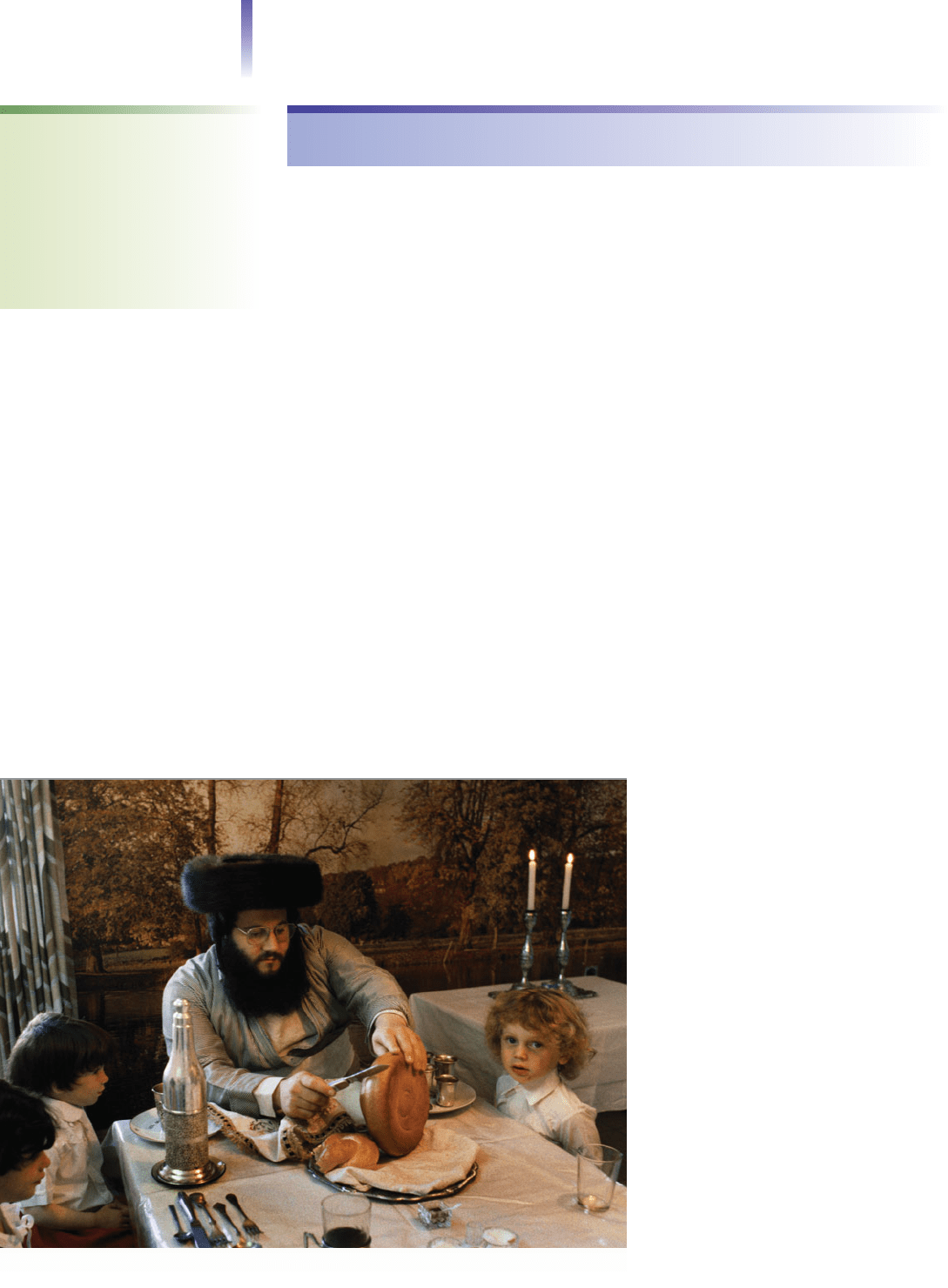
The World’s Major Religions
The largest of the thousands of religions in the world are listed in Figure 18.1 on the next
page. Let’s briefly review six of them.
Judaism
The origin of Judaism is traced to Abraham, who lived about four thousand years ago in
Mesopotamia. Jews believe that God (Jahweh) made a covenant with Abraham, selecting
his descendants as a chosen people—promising to make them “as numerous as the sands
of the seashore” and to give them a special land that would be theirs forever. The sign of
this covenant was the circumcision of males, which was to be performed when a boy was
eight days old. Descent is traced through Abraham and his wife, Sarah, their son Isaac,
and their grandson Jacob (also called Israel).
Joseph, a son of Jacob, was sold by his brothers into slavery and taken to Egypt.
Following a series of hair-raising adventures, Joseph became Pharaoh’s right-hand man.
When a severe famine hit Canaan, where Jacob’s family was living, Jacob and his eleven
other sons fled to Egypt. Under Joseph’s leadership, they were welcome. A subsequent
Pharaoh, however, enslaved the Israelites. After about four hundred years, Moses, an Is-
raelite who had been adopted by Pharaoh’s daughter, confronted Pharaoh. He persuaded
Pharaoh to release the slaves, who at that time numbered about 2 million. Moses led the
Israelites out of Egypt, but before they reached their Promised Land, they spent forty
years wandering in the desert. Sometime during those years, Moses delivered the Ten
Commandments from Mount Sinai. Abraham, Isaac, Jacob, and Moses hold revered po-
sitions in Judaism. The events of their lives and the recounting of the early history of the
Israelites are contained in the first five books of the Bible, called the Torah.
The founding of Judaism marked a fundamental change in religion, for it was the first
religion based on monotheism, the belief that there is only one God. Prior to Judaism,
religions were based on polytheism, the belief that there are many gods. In ancient Greek
religion, for example, Zeus was the god of heaven and earth, Poseidon the god of the sea,
and Athena the goddess of wisdom.
Other groups followed animism, be-
lieving that all objects in the world have
spirits, some of which are dangerous
and must be outwitted.
Contemporary Judaism in the
United States comprises three main
branches: Orthodox, Reform, and
Conservative. Orthodox Jews adhere
to the laws espoused by Moses. They
eat only foods prepared in a desig-
nated manner (kosher), observe the
Sabbath in a traditional way, and seg-
regate males and females in their reli-
gious services. During the 1800s, a
group that wanted to make their prac-
tices more compatible with U.S. cul-
ture broke from this tradition. This
liberal group, known as Reform Ju-
daism, mostly uses English in its reli-
gious ceremonies and has much less
ritual. The third branch, Conservative
Judaism, falls somewhere between the
other two. No branch has continued
to practice polygyny (allowing a man
to have more than one wife), the orig-
536 Chapter 18 RELIGION
monotheism the belief that
there is only one God
polytheism the belief that
there are many gods
animism the belief that all
objects in the world have spir-
its, some of which are danger-
ous and must be outwitted
Religion, which provides community and identity, is often passed from the older to the
younger. Shown here is a family of Hasidic Jews at the Sabbath table.

inal marriage custom of the Jews, which was outlawed by rabbinic decree
about a thousand years ago.
The history of Judaism is marked by conflict and persecution. The Is-
raelites were conquered by the Babylonians, and were again made slaves.
After returning to Israel and rebuilding the temple, they were later con-
quered by the Romans, and, after their rebellion at Masada in
A.D. 70 failed,
they were exiled for almost two thousand years into other nations. During
those centuries, they faced prejudice, discrimination, and persecution
(called anti-Semitism) by many peoples and rulers. The most horrendous
example was the Nazi Holocaust of World War II, when Hitler attempted
to eliminate the Jews as a people. Under the Nazi occupation of Europe
and North Africa, about 6 million Jews were slaughtered. Many died in gas
ovens that were constructed for just this purpose.
Central to Jewish teaching is the requirement to love God and do good
deeds. Good deeds begin in the family, where each member has an obligation
toward the others. Sin is a conscious choice to do evil and must be atoned for
by prayers and good works. Jews consider Jerusalem a holy city and believe that
one day the Messiah will appear there, bringing redemption for them all.
Christianity
Christianity, which developed out of Judaism, is also monotheistic. Christians
believe that Jesus is the Christ, the Messiah whom God promised the Jews.
Jesus was born in poverty, and traditional Christians believe his mother
was a virgin. Within two years of his birth, Herod—named king of Pales-
tine by Caesar, who had conquered Israel—was informed that people were
saying a new king had been born. When they realized Herod had sent sol-
diers to kill the baby, Jesus’ parents fled with him to Egypt. After Herod
died, they returned, settling in the small town of Nazareth.
At about the age of thirty, Jesus began a preaching and healing ministry.
His teachings challenged the contemporary religious establishment, and as
his popularity grew, the religious leaders plotted to have him killed by the
Romans. Christians interpret the death of Jesus as a blood sacrifice made
to atone for their sins. They believe that through his death they have peace
with God and will inherit eternal life.
The twelve main followers of Jesus, called apostles, believed that Jesus rose
from the dead. They preached the need to be “born again,” that is, to accept Jesus as Savior,
give up selfish ways, and live a devout life. The new religion spread rapidly, and after an ini-
tial period of hostility on the part of imperial Rome—during which time believers were fed
to the lions in the Coliseum—in
A.D. 317 Christianity became the empire’s official religion.
During the first thousand years of Christianity, there was only one church organization,
directed from Rome. During the eleventh century, after disagreement over doctrine and
politics, Greek Orthodoxy was declared independent of Rome. It was headquartered in
Constantinople (now Istanbul, Turkey). During the Middle Ages, the Roman Catholic
Church, which was aligned with the political establishment, became corrupt. Some Church
offices, such as that of bishop, were sold for a set price. The Reformation, which was led by
Martin Luther in the sixteenth century, was sparked by Luther’s outrage that the forgiveness
of sins (including those not yet committed) could be purchased by buying an “indulgence.”
Although Martin Luther’s original goal was to reform the Church, not divide it, the Re-
formation began a splintering of Christianity. The Reformation coincided with the breakup
of feudalism, and as the ancient political structure came apart, people clamored for inde-
pendence in both political and religious thought. Today, Christianity is the most popular re-
ligion in the world, with about 2 billion adherents. Christians are divided into hundreds of
groups, some with doctrinal differences so slight that only members of the group can appre-
ciate the extremely fine distinctions that they feel significantly separate them from others.
The Social Map on the next page shows how some of these groups are distributed in the
United States.
The World’s Major Religions 537
Muslims
1,200,000,000
Christians
2,000,000,000
Hindus
820,000,000
Chinese folk religions
390,000,000
Buddhists 360,000,000
Spiritists 12,000,000
Others: Baha’is 7,000,000
Confucians 6,000,000
Jains 4,000,000
Shintoists 3,000,000
Taoists 3,000,000
Zoroastrians 3,000,000
Sikhs 24,000,000
Jews 14,000,000
1
Note: The classification of religions is often
confusing. Animists, for example, although
numerous, are not listed as a separate group in
the source. It is sometimes difficult to tell what
groups are included in what categories.
Sources: “Adherents of . . . “ 2003.
FIGURE 18.1 The World’s
Largest Religions
1
anti-Semitism prejudice, dis-
crimination, and persecution
directed against Jews

Islam
Islam, whose followers are known as Muslims, began in the same part of the world as
Judaism and Christianity. Islam, the world’s third monotheistic religion, has over a billion
followers. It was founded by Muhammad, who was born in Mecca (now in Saudi Arabia)
in about
A.D. 570. Muhammad married Khadija, a wealthy widow. About the age of 40,
he reported that he had had visions from God. These, and his teachings, were later writ-
ten down in a book called the Qur’an (Koran). Few paid attention to Muhammad, al-
though Ali, his son-in-law, believed him. When he found out that there was a plot to
murder him, Muhammad fled to Medina, where he found a more receptive audience.
There he established a theocracy (a government based on the principle that God is king,
God’s laws are the statutes of the land, and priests are the earthly administrators of God).
In
A.D. 630 he returned to Mecca, this time as a conqueror (Bridgwater 1953).
After Muhammad’s death, a struggle for control over the empire he had founded split
Islam into two branches that remain today, the Sunni and the Shi’ite. The Shi’ites believe
that the imam (the religious leader) is inspired as he interprets the Qur’an. They are gen-
erally more conservative and are inclined to fundamentalism, the belief that modern
ways of life threaten religion and that the faith as it was originally practiced should be re-
stored. The Sunnis, who do not share this belief, are generally more liberal, more accept-
ing of social change.
Like the Jews, Muslims trace their ancestry to Abraham. Abraham fathered a son,
Ishmael, by Hagar, his wife Sarah’s Egyptian maid (Genesis 25:12). Ishmael had twelve
538 Chapter 18 RELIGION
Reported church membership 25+%
Baptist
Catholic
Latter-da
y
Saints
Lutheran
Methodist
No Dominant Group
FIGURE 18.2 Church Membership: Dominant Religion, by County
When no religious group has 25 percent of the total membership in a county, that county is left blank. When two or more religious groups
have 25–49 percent of the membership in a county, the largest is shown.
Source: Reprinted with permission from Religious Congregations and Membership in the United States: 2000. (Nashville: Glenmary
Research Center, 2002). © Association of Statisticians of American Religious Bodies. All rights reserved.
fundamentalism the belief
that social change, especially in
values, is threatening true reli-
gion and that the religion
needs to go back to its funda-
mentals (roots, basic beliefs,
and practices)

sons, from whom a good portion of today’s Arab world is descended. For them also,
Jerusalem is a holy city. The Muslims consider the Bibles of the Jews and the Chris-
tians to be sacred, but they take the Qur’an as the final word. They believe that the fol-
lowers of Abraham and Moses (Jews) and Jesus (Christians) changed the original
teachings and that Muhammad restored these teachings to their initial purity. It is the
duty of each Muslim to make a pilgrimage to Mecca during his or her lifetime. Un-
like the Jews, the Muslims continue to practice polygyny. They limit a man to four
wives, however.
Hinduism
Unlike the other religions just described, Hinduism has no specific founder. Going back
about four thousand years, Hinduism was the chief religion of India. The term Hinduism,
however, is Western, and in India the closest term is dharma (law). Unlike Judaism, Chris-
tianity, and Islam, Hinduism has no canonical scripture, that is, no texts thought to be in-
spired by God. Instead, several books, including the Brahmanas, Bhagavad-Gita, and
Upanishads, expound on the moral qualities that people should strive to develop. They
also delineate the sacrifices people should make to the gods.
Hindus are polytheists; that is, they believe that there are many gods. They believe
that one of these gods, Brahma, created the universe. Brahma, along with Shiva (the
Destroyer) and Vishnu (the Preserver), form a triad that is at the center of modern
Hinduism. A central belief is karma, spiritual progress. There is no final judgment, but,
instead, reincarnation, a cycle of life, death, and rebirth. Death involves only the
body. The soul continues its existence, coming back in a form that matches the indi-
vidual’s moral progress in the previous life (which centers on proper conduct in follow-
ing the rules of one’s caste). If an individual reaches spiritual perfection, he or she has
attained nirvana. This marks the end of the cycle of death and rebirth, when the soul
is reunited with the universal soul. When this occurs, maya, the illusion of time and
space, has been conquered.
Some Hindu practices have been modified as a consequence of social protest—espe-
cially child marriage and suttee, the practice of cremating a surviving widow along with
her deceased husband (Bridgwater 1953). Other ancient rituals remain unchanged, how-
ever, and include kumbh mela, a purifying washing in the Ganges River, which takes place
every twelve years, and in which many millions participate.
The World’s Major Religions 539
reincarnation in Hinduism
and Buddhism, the return of
the soul (or self) after death in
a different form
Worshippers of Ganesh, the
elephant-headed god, during a
festival in Mumbai, India

Buddhism
In about 600 B.C., Siddhartha Gautama founded Buddhism. (Buddha means the “en-
lightened one,” a term Gautama was given by his disciples.) Gautama was the son of an
upper-caste Hindu ruler in an area north of Benares, India. At the age of 29, he renounced
his life of luxury and became an ascetic. Through meditation, he discovered the “four
noble truths,” which emphasize self-denial and compassion:
1. Existence is suffering.
2. The origin of suffering is desire.
3. Suffering ceases when desire ceases.
4. The way to end desire is to follow the “noble eightfold path.”
The noble eightfold path consists of
1. Right belief
2. Right resolve (to renounce carnal pleasure and to harm no living creature)
3. Right speech
4. Right conduct
5. Right occupation or living
6. Right effort
7. Right-mindedness (or contemplation)
8. Right ecstasy
The central symbol of Buddhism is the eight-spoked wheel. Each spoke represents one
aspect of the path. As with Hinduism, the ultimate goal of Buddhism is the cessation of
rebirth and thereby of suffering. Buddhists teach that all things are temporary, even the
self. Because all things are destined to pass away, there is no soul (Reat 1994).
Buddhism spread rapidly. In the third century
B.C., the ruler of India adopted Bud-
dhism and sent missionaries throughout Asia to spread the new teaching (Bridgwater
1953). By the fifth century
A.D., Buddhism reached the height of its popularity in India,
after which it died out. Buddhism, however, had spread to Ceylon, Burma, Tibet, Laos,
Cambodia, Thailand, China, Korea, and Japan, where it flourishes today. With increased
immigration from Asian nations, vigorous communities of Buddhists have developed in
the United States (Cadge and Bender 2004).
Confucianism
About the time that Gautama lived, K’ung Fu-tsu (551–479 B.C.) was born in China. Con-
fucius (his name strung together in English), a public official, was distressed by the corruption
that he saw in government. Unlike Gautama, who urged withdrawal from social activities,
Confucius urged social reform and developed a system of moral principles based on peace,
justice, and universal order. His teachings were incorporated into writings called the Analects.
The basic moral principle of Confucianism is to maintain jen, sympathy or concern for
other humans. The key to jen is to sustain right relationships—being loyal and placing
morality above self-interest. In what is called the “Confucian Golden Rule,” Confucius
stated a basic principle for jen: to treat those who are subordinate to you as you would like
to be treated by people superior to yourself. Confucius taught that right relationships
within the family (loyalty, respect) should be the model for society. He also taught the
“middle way,” an avoidance of extremes.
Confucianism was originally atheistic, simply a set of moral teachings without reference to
the supernatural. As the centuries passed, however, local gods were added to the teachings,
and Confucius himself was declared a god. Confucius’ teachings became the basis for the gov-
ernment of China. About
A.D. 1000, the emphasis on meditation gave way to a stress on im-
provement through acquiring knowledge. This emphasis remained dominant until the
twentieth century. By this time, the government had become rigid, and respect for the exist-
ing order had replaced respect for relationships (Bridgwater 1953). Following the Communist
revolution of 1949, political leaders attempted to weaken the people’s ties with Confucianism.
They succeeded in part, but Confucianism remains embedded in Chinese culture.
540 Chapter 18 RELIGION
